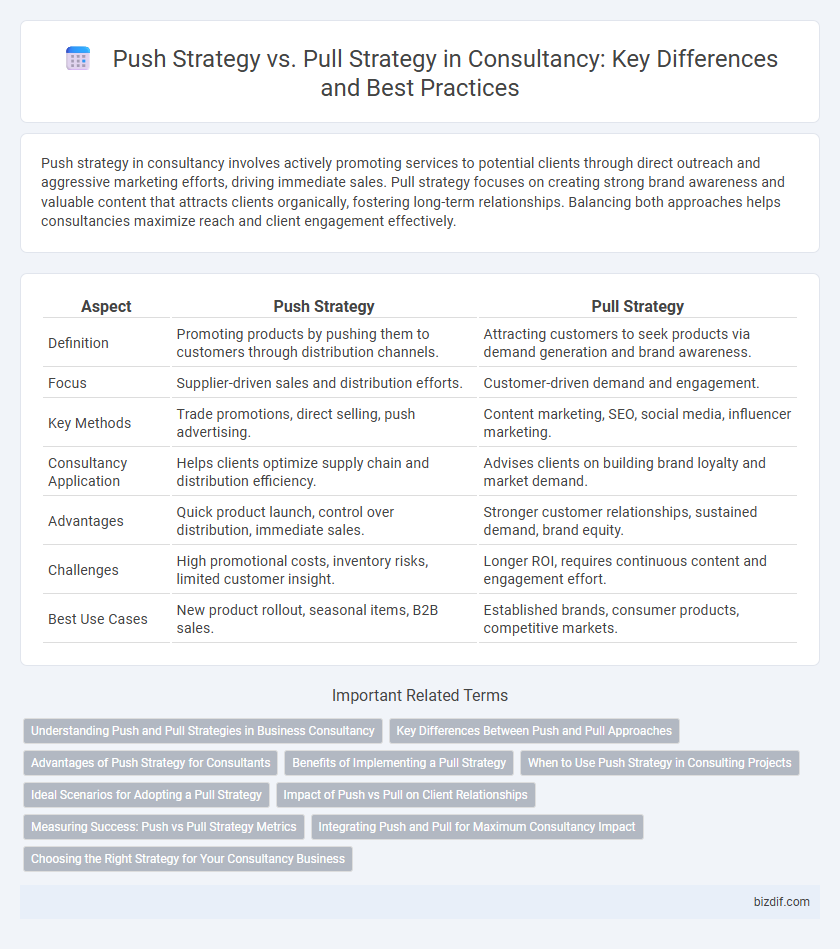Push strategy in consultancy involves actively promoting services to potential clients through direct outreach and aggressive marketing efforts, driving immediate sales. Pull strategy focuses on creating strong brand awareness and valuable content that attracts clients organically, fostering long-term relationships. Balancing both approaches helps consultancies maximize reach and client engagement effectively.
Table of Comparison
| Aspect | Push Strategy | Pull Strategy |
|---|---|---|
| Definition | Promoting products by pushing them to customers through distribution channels. | Attracting customers to seek products via demand generation and brand awareness. |
| Focus | Supplier-driven sales and distribution efforts. | Customer-driven demand and engagement. |
| Key Methods | Trade promotions, direct selling, push advertising. | Content marketing, SEO, social media, influencer marketing. |
| Consultancy Application | Helps clients optimize supply chain and distribution efficiency. | Advises clients on building brand loyalty and market demand. |
| Advantages | Quick product launch, control over distribution, immediate sales. | Stronger customer relationships, sustained demand, brand equity. |
| Challenges | High promotional costs, inventory risks, limited customer insight. | Longer ROI, requires continuous content and engagement effort. |
| Best Use Cases | New product rollout, seasonal items, B2B sales. | Established brands, consumer products, competitive markets. |
Understanding Push and Pull Strategies in Business Consultancy
Push strategy in business consultancy involves proactively promoting products or services to clients through direct outreach, advertising, and sales efforts, aiming to generate immediate demand. Pull strategy focuses on creating strong brand awareness and customer loyalty by leveraging content marketing, customer engagement, and inbound tactics that attract clients organically. Understanding these strategies enables consultants to tailor marketing plans that optimize client acquisition and retention based on target audience behavior and market dynamics.
Key Differences Between Push and Pull Approaches
Push strategy emphasizes proactive promotion by directly targeting customers through aggressive advertising, sales promotions, and personal selling, ensuring immediate product availability and market penetration. Pull strategy relies on creating strong consumer demand via branding, content marketing, and word-of-mouth, driving customers to seek out the product independently. Key differences include the push tactic's focus on supply chain influence and immediate sales uplift versus the pull tactic's emphasis on long-term brand loyalty and demand creation.
Advantages of Push Strategy for Consultants
Push strategy enables consultants to proactively introduce their expertise and services directly to targeted clients, enhancing brand visibility and accelerating client acquisition. This approach allows for precise control over messaging and timing, which improves lead generation efficiency and fosters stronger client relationships. Leveraging push tactics helps consultants swiftly address market demands while differentiating their offerings in a competitive landscape.
Benefits of Implementing a Pull Strategy
Implementing a pull strategy enhances customer engagement by attracting demand through targeted content and personalized experiences, leading to increased brand loyalty and higher conversion rates. It reduces inventory costs and minimizes waste by aligning production closely with actual consumer demand. This strategy leverages digital platforms and data analytics to create a more efficient and responsive supply chain, fostering sustainable growth.
When to Use Push Strategy in Consulting Projects
Push strategy in consulting projects is effective when launching new products, entering new markets, or promoting time-sensitive services requiring immediate client engagement. It works best when consultants need to proactively drive demand by targeting specific customer segments through direct communication, sales promotions, or personalized outreach. Organizations facing strong competition or limited brand awareness benefit from push strategies to accelerate market penetration and establish client relationships quickly.
Ideal Scenarios for Adopting a Pull Strategy
Implementing a pull strategy is ideal in markets with highly informed consumers who actively seek product information and demonstrate strong brand loyalty, such as technology and luxury goods sectors. This approach excels when demand is driven by customer preferences and when the goal is to create sustained engagement through content marketing, social media, and influencer partnerships. Pull strategies also suit businesses aiming to optimize inventory turnover by producing goods based on actual consumer demand rather than speculative forecasting.
Impact of Push vs Pull on Client Relationships
Push strategy fosters direct communication and proactive engagement, which can establish immediate client connections but may risk perceived intrusion. Pull strategy encourages clients to seek out information, promoting trust and long-term relationship building through value-driven content and solutions. Balancing push and pull tactics enhances client retention by aligning outreach methods with client preferences and engagement behaviors.
Measuring Success: Push vs Pull Strategy Metrics
Measuring success in push strategy involves tracking direct sales volume, conversion rates from promotional campaigns, and distribution channel effectiveness. In contrast, pull strategy metrics emphasize brand awareness, customer engagement levels, and organic traffic growth from inbound marketing efforts. Utilizing key performance indicators (KPIs) such as return on investment (ROI), customer acquisition costs, and lifetime value helps optimize both push and pull strategies in consultancy.
Integrating Push and Pull for Maximum Consultancy Impact
Integrating push and pull strategies in consultancy enhances client engagement by proactively delivering tailored solutions (push) while simultaneously attracting clients through value-driven content and reputation (pull). Data-driven insights and market analysis enable consultants to calibrate the balance between outbound initiatives and inbound interest, optimizing resource allocation for sustained growth. Combining these approaches ensures a dynamic, adaptive consultancy model that maximizes outreach, conversion rates, and long-term client loyalty.
Choosing the Right Strategy for Your Consultancy Business
Selecting the appropriate marketing approach is crucial for consultancy businesses aiming to maximize client acquisition and retention. Push strategy leverages direct outreach methods such as cold calling and targeted advertising to proactively present services to potential clients, generating immediate leads. Pull strategy focuses on creating valuable content, strong brand presence, and thought leadership to attract clients organically, fostering long-term trust and engagement.
Push Strategy vs Pull Strategy Infographic

 bizdif.com
bizdif.com